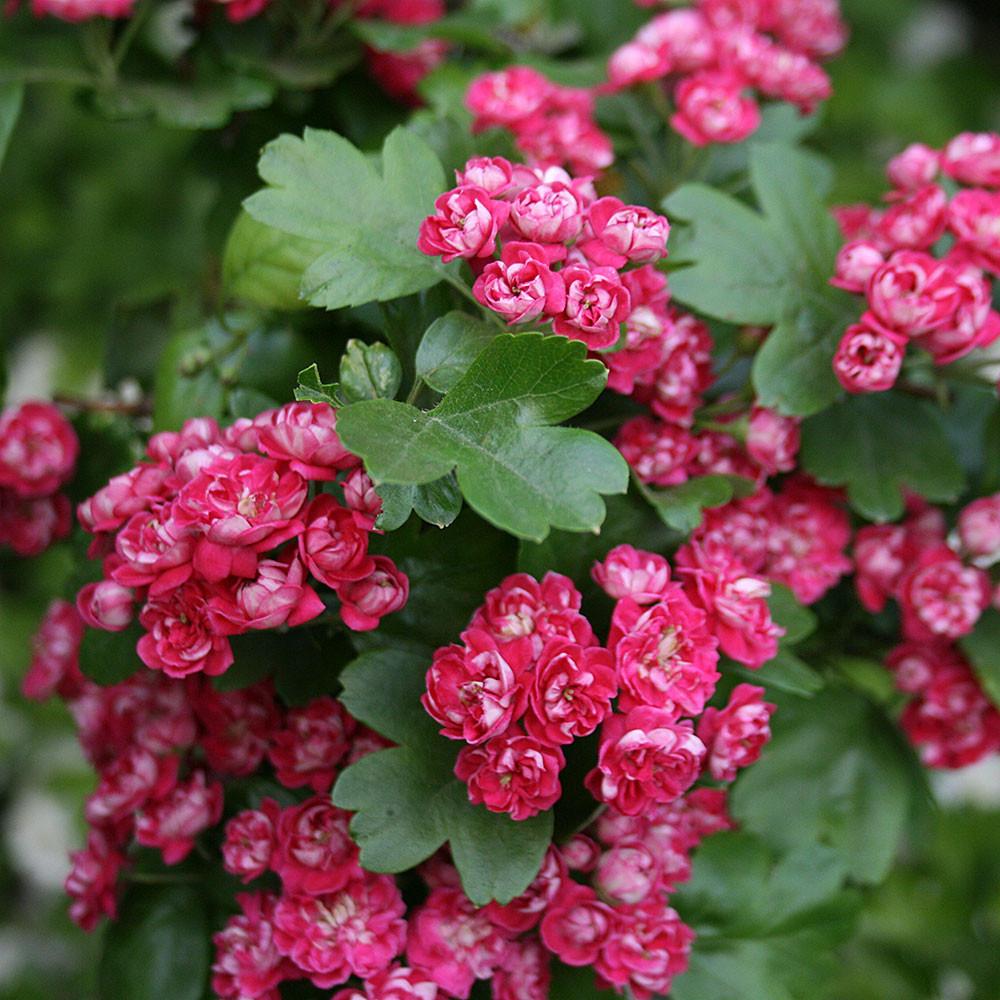Crataegus Pauls Scarlet / Red Hawthorn
£240.00
Frequently Bought Together




Description
Quick Facts
- Common Name: Paul’s Scarlet Hawthorn, Double Red Hawthorn, Midland Hawthorn
- Botanical Name: Crataegus laevigata ‘Paul’s Scarlet’
- Plant Type: Deciduous tree
- Mature Height: 6-8m
- Mature Spread: 5-7m
- Flowering Period: May to June
- Flower Colour: Deep rose-pink to scarlet-red, double flowers
- Foliage: Lobed leaves, glossy dark green
- Hardiness: RHS H7 (very hardy)
- Soil Requirements: Moist, well-drained, tolerates most soil types including clay and chalk
- Aspect: Full sun to partial shade
- Maintenance: Low
Description
Experience the spectacular beauty of Crataegus laevigata ‘Paul’s Scarlet’, the stunning Paul’s Scarlet Hawthorn that brings exceptional spring colour, romantic charm, and compact elegance with its masses of double rose-pink flowers. This outstanding ornamental hawthorn offers remarkable qualities—abundant double flowers in deep rose-pink to scarlet-red that smother the branches in late spring creating one of the most spectacular flowering displays of the season, each flower measuring 2cm across with multiple layers of petals creating full, rosette-like blooms far more showy than single hawthorn flowers, compact rounded form that remains manageable in size making this perfect for small to medium gardens where larger flowering trees would be too big, exceptional hardiness and adaptability to challenging conditions including urban pollution, exposed sites, clay soils, and coastal locations, making this one of the finest and most reliable small flowering trees for creating breathtaking spring drama, romantic beauty, and year-round structure to your garden.
Throughout late spring (May-June), this captivating tree becomes completely transformed when it bursts into spectacular bloom. The branches become absolutely smothered in clusters of double flowers in deep rose-pink to scarlet-red, creating one of the most stunning flowering displays imaginable—the entire tree appears to be covered in a cloud of pink blooms. Each individual flower measures approximately 2cm across with multiple layers of petals arranged in rosette form, creating much fuller, showier blooms than the simple five-petalled flowers of common hawthorn. The flowers are held in dense clusters (corymbs) all along the branches, creating maximum impact. The overall effect is breathtaking—pure romantic beauty that stops visitors in their tracks. The flowers are followed by glossy dark green lobed leaves measuring 2-5cm long with three to five shallow lobes and serrated edges, creating attractive summer foliage. Because the flowers are double and sterile, this cultivar produces few or no berries (haws), unlike common hawthorn. The compact, rounded crown creates neat form, and the grey-brown bark becomes slightly fissured with age. In autumn, the foliage turns soft yellow-bronze before falling.
This remarkable cultivar was raised in England in the mid-19th century and named after its breeder, and has been a cherished garden tree ever since for its spectacular double flowers. It’s a selected form of the native Midland Hawthorn (Crataegus laevigata), which differs from Common Hawthorn (C. monogyna) in having shallower leaf lobes and flowers with two styles rather than one. Exceptionally hardy and remarkably adaptable, this hawthorn thrives in British conditions, tolerating urban pollution, exposure, coastal winds, clay soils, chalk, compacted soils, and challenging sites where many trees would struggle. The compact size makes this ideal for smaller gardens, whilst the spectacular spring flowering provides as much impact as much larger trees. A true cottage garden classic that suits both traditional and contemporary landscapes.
Create stunning compositions by planting as spectacular specimen trees in lawns, cottage gardens, or prominent positions where the breathtaking spring flowering can be fully appreciated. Exceptional in small to medium gardens where space is limited but maximum spring colour is desired. Works beautifully in mixed borders, traditional cottage gardens, or as focal points in contemporary designs. Magnificent as street trees, courtyard features, or planted in groups for enhanced impact. The compact size makes this ideal for urban gardens, front gardens, or anywhere a manageable flowering tree is needed. Plant where the masses of pink blooms can be enjoyed from windows and where they create romantic spring atmosphere.
Caragh Garden Notebook
Planting: Space trees 6-7m apart if planting multiples, or allow 7-8m for specimen placement to accommodate the mature spread. Plant bare-root trees from November to March, or container-grown specimens year-round (autumn or early spring is ideal). Dig holes twice the width of the root ball and incorporate organic matter. Plant at the same depth as the nursery soil mark. Stake for the first 2-3 years. Water thoroughly and mulch around the base. Choose positions in full sun for best flowering—tolerates partial shade but flower production may be reduced.
Soil Preparation: Thrives in moist, well-drained soil with pH 6.0-8.0. Tolerates a remarkably wide range of soil types including heavy clay, loam, sand, chalk, and moderately acidic to alkaline conditions—one of the most adaptable trees. Prefers moisture-retentive, fertile conditions but performs well even in poor, compacted soils. Dislikes waterlogged sites. Exceptionally tolerant of urban pollution, exposure, coastal conditions, and challenging sites. Best flowering occurs in full sun with reasonable soil, though very forgiving of less-than-ideal conditions.
Container Growing: Can be grown in large containers (minimum 60cm diameter) using soil-based compost for several years, creating spectacular patio features with spring flowering. Water regularly during growing season and feed in spring with slow-release balanced fertiliser. However, for best long-term health, maximum flowering, and to achieve the full rounded form, plant out into the ground where the root system can develop fully and the tree can reach its full potential.
Seasonal Care: Requires minimal pruning—the naturally rounded form develops without intervention. Remove only dead, damaged, or crossing branches in late winter when dormant. If shaping is needed, prune immediately after flowering in early summer—avoid autumn/winter pruning as this removes flowering wood. Can be lightly trimmed to maintain size if needed. Apply slow-release balanced fertiliser in early spring if desired, though hawthorns are generally undemanding. Mulch annually with organic matter. Water during dry spells in the first 3-5 years until established—very drought-tolerant once mature. Generally pest and disease resistant, though can occasionally be affected by leaf spot, powdery mildew, or fireblight in some areas.
Propagation: Cannot be propagated from seed as this is a selected cultivar that will not come true from seed and will revert to single-flowered forms. The double flowers are largely sterile and produce few seeds. Professional propagation is by grafting or budding onto Crataegus rootstock (typically C. monogyna or C. laevigata) in winter or summer. Home gardeners should purchase nursery-grown grafted specimens for guaranteed quality, reliable double flowering, and characteristic rose-pink colour.
This romantic beauty is absolutely stunning—those masses of double rose-pink flowers smothering the branches in late spring create one of the most spectacular flowering displays imaginable! Pure cottage garden charm and breathtaking colour. Compact size perfect for smaller gardens, exceptionally hardy, tolerates challenging conditions brilliantly including clay, chalk, urban pollution, and coastal sites. Low maintenance, reliable flowering, and that romantic spring display is unforgettable. A true garden classic!
Additional information
| Size | 14-16cm girth Standard, 35L 10-12cm girth, 35L 10-12cm girth Prunued, 35L 8-10cm girth, 2-2.5m, 90L 16-18cm girth, 4.5metres, 08-10cm girth, 3-3.5m tall, Rootballed, 10-12cm girth, 3-3.5m tall, Rootballed, 12-14cm girth, 3-3.5m tall, Rootballed, 14-16cm girth, 3.5-4m tall, Rootballed, 16-18cm girth, 3.5-4m tall, Rootballed, 45L 10-12cm girth, Standard, 45L 8-10cm girth 3metres |
|---|





